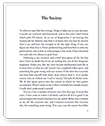Essay Instructions: this 6 pg Midterm ppr is for Clinical Practice I class for 1st yr MSW College. Assgmt: Engagement & Development of the Treatment Relationship. In this assgmt, u r asked to demonstrate through the use of readings and process recording excerpts how you determined a client's capacity to engage in the treatment relationship and how you used this info to help the client enter the helping process. You should show how your understanding incorporated relevant data about client needs, motivational readiness to change and resources available (personal and /or environmental).
A) Introduction:
In 2-3 paragraphs, briefly describe your agency, your function in the agency, who the client is (demographic data), and how the client came to your agency and you. What does the client want from you?
Agency: CUCS. CUCS serves homeless and low income adults & families. The majority of the clients served are diagnosed with serious mental illness, HIV/AIDS, alcohol abuse/dependency, and other chronic medical conditions. The agency provides social services for tenants at a handful of transitional and permanent supportive housing sites throughout Brooklyn, the Bronx, and Manhattan. The agency also provides on-site psychiatric and primary care medical svcs and employmnet svcs. to tenants and community members.
I will be working with clients who are seeking competitive emplymnt, who may either find ambivalence/MH as being an obstacle to employment (getting the interview, getting hired, and keeping the job). I will be helping them brush-up their resumes, coaching them with their ambivalence to enter the workfield again, helping them with MH, taking them to interview/ or to get interview clothes. My caseload will consist of diverse group of single adults. Some clients are referred by HASA, an AIDS program. Others are referred by Psychiatric Hospital or various agencies for the homeless. I will assist in an emplymt group, where participants learn work ethics, do mock interviews, learn/brush up on their work skills. I will use motivational interview techniques, CBT, drawing on client's strengths. Build up their insecurities with self-esteem.
B)
What You Brought to the Therapeutic Encounter
Discuss your practice theory and any thoughts and feelings you had about the client before you met with him/her. Based on the info available, what did you anticipate? How did your experience, the avail client info, and your practice theory inform your thinking and help you plan for the initial helping encounters? Be specific. Share your precise thoughts about the client. State what your practice theory suggested about clients in this particular circumstance.
I will use the Strengths-based Perspective, Life Model Perspective, Ego Psychology/functions perspective, person in evironment. (refer to book: Social Casework by Woods & Hollis, and and Ego Psychology by E. Goldstien)
C)
The Helping-Therapeutic Encounter
Using up to some process recording excerpts/summaries, present a section of your initial encounter with the client. The encounter you select should illustrate salient aspects of the client's response to your efforts to engage him/her. It should also include examples of the data( e.g. client verbal and non-verbal responses) that you used to assess the client's capacity to engage in the client-worker relationship and a therapeutic helping process. Following each response by you include in parenthesis a sentence, or two, that explains what you were thinking and why you responded as you did. For example, what were you trying to accomplish? what were you feeling?
D)
Initial Formulations (motivation for change, strengths)
Include the following in your evaluation of the client's capacity to engage in the treatment relationship. Will the client have difficulty working with you toward the identified change outcome? How so? What leads you to this conclusion? What client strengths and resources are available to assist you and the client? Provide literature citations and examples from the initial phase of the helping encounter to support your conclusions. If you anticipate no difficulties on the client's part, explain how you reached this conclusion.
How do you explain the client's difficulty in engaging in the treatment relationship? What interventions can you identify that may guide your efforts in strengthening the treatment relationship?
Indicate the next steps you will take to enhance the client-practitioner (treatment) relationship. Be specific. Provide a range of options if necessary. Explain the rationale behind these steps.
Please refer to the uploaded literature and infuse citations throught the paper.


